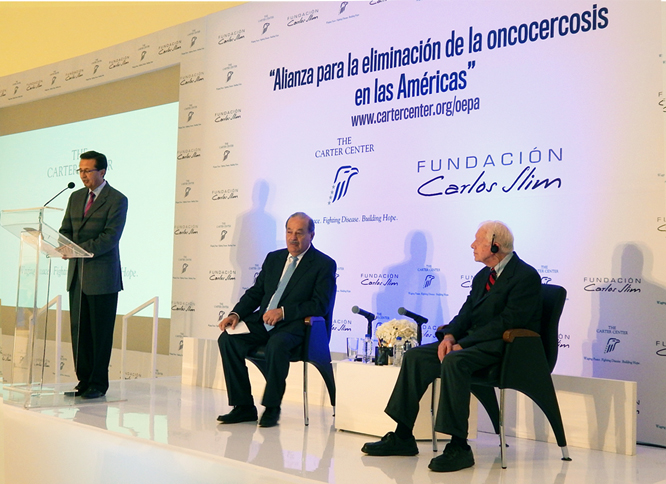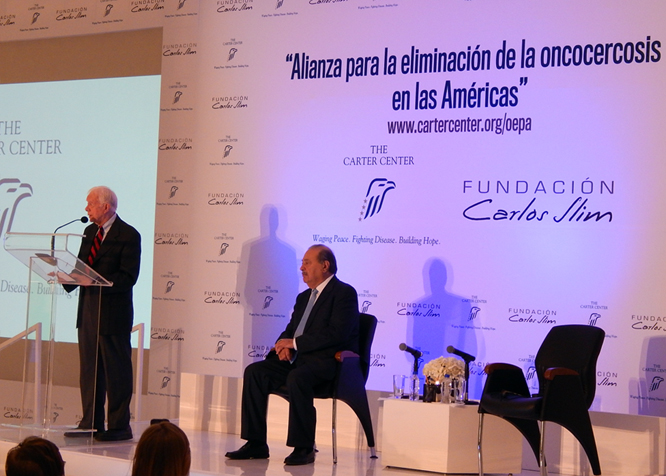
Jimmy Carter and Carlos Slim Announce New Partnership to Help Eliminate Last Vestiges of River Blindness in the Americas
November 13, 2014. Mexico City
- Partnership Supports a Regional Initiative that has Reduced the Population
at Risk for the Disease by 95% in the Americas since 1993
Former U.S. President Jimmy Carter and Mexican businessman Carlos Slim announced today a partnership to assist the regional initiative working with six countries in the Americas to eliminate river blindness (onchocerciasis): Brazil, Colombia, Ecuador, Guatemala, Mexico and Venezuela. The announcement comes as the Mexican government celebrates eliminating transmission of river blindness nationwide, joining Colombia, Ecuador, and Guatemala.
"This unique contribution from Carlos Slim further demonstrates Mexico's global health leadership and the overall spirit of international commitment to ensure that all people in Latin America can enjoy the river blindness success we celebrate today in Mexico." said former U.S. President Jimmy Carter, founder of The Carter Center, which works with the countries and partners throughout Latin America to eliminate the disease through its regional initiative, the Onchocerciasis Elimination Program for the Americas (OEPA).
Mexico's success is the culmination of a more than 80-year national effort to first control, and then eliminate, the debilitating disease. Mr. Slim announced this integral alliance between the Carlos Slim Foundation and the Carter Center to bolster OEPA's efforts to assist the remaining countries, Brazil and Venezuela, to target the Americas' final cases of river blindness which are located in Yanomami communities deep in the Amazon rain forest.
"We are proud to join The Carter Center in its partnership with affected countries to stop the scourge of this dreaded disease once and for all. Eliminating a disease like river blindness is the right thing to do, we are committed to support the health, education and well-being of Mexican and Latin American populations," said Carlos Slim, founder of the Carlos Slim Foundation.
River Blindness (onchocerciasis) is classified as one of the 17 Neglected Tropical Diseases (NTDs) by the World Health Organization (WHO). It is caused by a worm parasite (Onchocerca volvulus) that is transmitted through the bites of flies that breed in rapidly flowing waters along fertile river banks. The infection can cause intense itching, skin discoloration and disfigurement, eyesight damage, and blindness. In addition to the suffering it causes, the disease has an economic impact, reducing an individual's ability to work and learn.
Due to the dedication of the six ministries of health and thousands of community-based health workers, today the population at risk for river blindness in the Americas has been reduced by more than 95 percent.
About the Carlos Slim Foundation
Created in 1986 to impact the most vulnerable populations, the Carlos Slim Foundation has directly benefited millions of people. With a marked sense of social responsibility, efficiency, and proven results, the Foundation has programs in various fields, such as education, employment, health, nutrition, social justice, culture, human development, support during natural disasters, protection and conservation of the environment, and economic development. These programs help improve the quality of life for populations of all ages, fostering the development of human capital and generating opportunities for people, their communities, and their countries.
As part of the Carlos Slim Foundation, the Health Institute has the purpose to generate solutions in order to help solve Mexico's and Latin America's main public health problems focusing on the most vulnerable populations.
About The Carter Center
A not-for-profit, nongovernmental organization, The Carter Center has helped to improve life for people in more than 80 countries by resolving conflicts; advancing democracy, human rights, and economic opportunity; preventing diseases; and improving mental health care. The Center was founded in 1982 by former U.S. President Jimmy Carter and his wife, Rosalynn, in partnership with Emory University, to advance peace and health worldwide.For more than two decades, The Carter Center has continued to pioneer multiple disease elimination projects in Africa and Latin America.
ADDITIONAL INFORMATION ON THE INITIATIVE
An Eighty Year Battle against River Blindness in Mexico
Mexico's first case of river blindness was diagnosed by Dr. Friedrich Fülleborn in 1923. In 1930, the national program to combat the disease was launched, based on a strategy of surgical removal of the subcutaneous nodules formed by the adult worms. Mass distribution of the safe and effective oral medication Mectizan®, donated by Merck, began to be used by the program in 1988. When the OEPA joined the fight against river blindness in 1993, cases were located in three transmission zones (foci) in two southern states, Oaxaca and Chiapas.
Onchocerciasis was wiped out from the Northern Chiapas focus and Oaxaca focus by the late 2000s using a strategy of semiannual distribution of Mectizan and health education. Southern Chiapas used both semiannual and quarterly treatments to eliminate onchocerciasis, completing its post-treatment surveillance phase in 2013. The country soon will apply to the WHO for formal verification as river blindness-free. Today, as a result of country leadership and strong partnerships, there are approximately 170,000 people in Mexico's three formerly-endemic areas who are now no longer at risk of contracting river blindness.
River Blindness in the Americas
In the late 1980s an estimated 500,000 people in the Americas were at risk of river blindness in six countries: Brazil, Colombia, Ecuador, Guatemala, Mexico, and Venezuela. The donation of Mectizan by Merck stimulated new partnerships and opportunities to fight river blindness. The OEPA program has played a key role in providing technical and complementary financial support to countries since its launch, following a 1991 Pan American Health Organization (PAHO) resolution to eliminate the disease from the region (CD35.R14); PAHO serves as WHO's Regional Office for the Americas. OEPA was launched in 1993 with funding from the River Blindness Foundation; The Carter Center absorbed the River Blindness Foundation in 1996.
Today, the population requiring Mectizan treatment in the Americas has been reduced by more than 95 percent.
In 2013, Colombia became the first country officially verified by the WHO as free of onchocerciasis, and on Sept. 22, 2014, Ecuador was the second to country receive WHO verification. The governments of Guatemala and Mexico have both eliminated disease transmission, completed their post-treatment surveillance period, and are getting ready to start the official process to request verification from the WHO.
Transmission only continues in the cross-border region between Venezuela and Brazil, commonly referred to as the Yanomami area. Interrupting onchocerciasis transmission from this final area in the Americas is the biggest challenge to the regional initiative, particularly due to the scattered migratory Yanomami population, who live in the dense, nearly inaccessible terrain of the deep Amazon rainforest. The Ministries of Health in Brazil and Venezuela are working with The Carter Center/OEPA, PAHO and other partners to meet the goal of verifying the elimination of onchocerciasis from the Americas by 2019.
In May 2014, a new binational agreement between Brazil and Venezuela dedicated to finishing the job of onchocerciasis elimination in those countries was signed. The agreement shows that the political will exists in those two countries to undertake the challenging task of providing Mectizan tablets to the remote indigenous communities that straddle their common border. Over the next four years, support from the Carlos Slim Health Institute will allow OEPA to intensify support to these national efforts to develop the binational program as conceived and executed by the countries, as well as to assist WHO/PAHO in its process of international verification of elimination of the disease from the entire region.
River Blindness in Africa
The progress in the Americas has been a beacon of hope for river blindness elimination efforts in Africa, where more than 120 million people in 31 countries are at risk and hundreds of thousands have been blinded by the condition. In Africa, The Carter Center assists the ministries of health of Uganda, Sudan, and areas of Ethiopia and Nigeria. As of August 2014, The Carter Center has assisted in delivery of approximately 200 million cumulative treatments of Mectizan through community-based channels worldwide. Using lesson learned from the partnership in the Americas, the Center hopes to demonstrate practical approaches to river blindness transmission elimination in Africa .
Strong Partnerships
The effort to wipe out river blindness from the Americas is a result of strong partnerships that include: thousands of community-based volunteers, the ministries of health of the six endemic countries, The Carter Center, the U. S. Centers for Disease Control and Prevention (CDC), the Pan America Health Organization, Merck and the Mectizan Donation Program, Carlos Slim Foundation, the Bill & Melinda Gates Foundation, the United States Agency for International Development (USAID), the Lions Clubs International Foundation and the local Lions Clubs from the six countries, Mr. John Moores and the former River Blindness Foundation, the OPEC Fund for International Development, the Alwaleed Bin-Talal Foundation, the Inter-American Development Bank, several universities in Latin America and the United States, and many other individual donors.



| << back |
